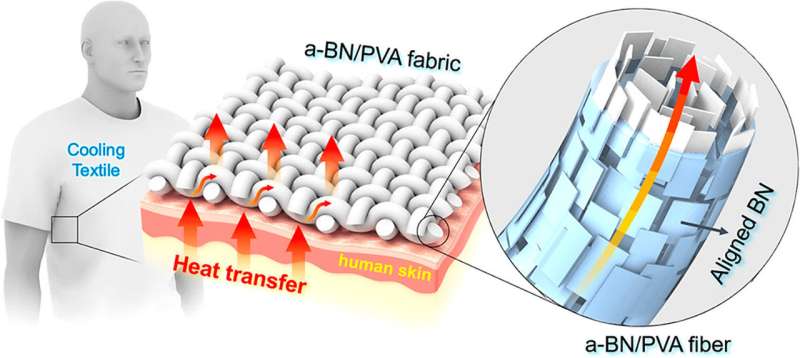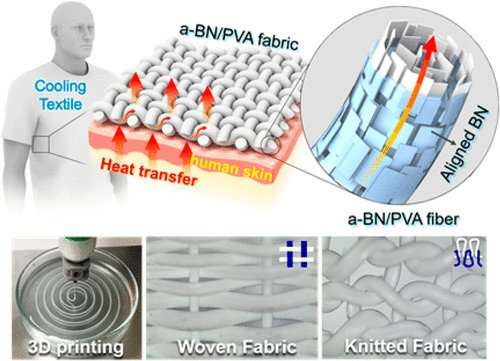Cool textiles to beat the heat

Air-conditioned buildings bring welcome relief to people coming in from the heat. But creating that comfort comes with a cost to our wallets and the environment in the form of increased energy bills and greenhouse gas emissions. Now researchers report in ACS Nano the development of a new material for clothing that we could one day don as our own personal cooling unit, without any external energy needed to power it.
Functionalized clothes have become the norm in recent years. We now have moisture-wicking and smell-proof athletic gear, and shirts and tops coated with a chemical layer that blocks ultraviolet rays. Clothes that help cool us down, however, have been harder to achieve. So far, such attempts have resulted in materials that incorporate bulky components, require a lot of energy or are expensive. Liangbing Hu and colleagues at University of Maryland College Park wanted to see if they could come up with a more practical option.
The researchers combined boron nitride—a material that transfers heat—and polyvinyl alcohol to create a nanocomposite fiber that can be 3-D printed and woven into fabric. Testing to simulate the material on skin showed that the composite is 1.5 to 2 times more efficient at moving heat away from the body when compared to pure polyvinyl alcohol or cotton fabrics, respectively. Making clothes with the nanocomposite thread could help keep wearers comfortable and reduce the need to cool entire buildings, the researchers say.

More information: Tingting Gao et al. Three-Dimensional Printed Thermal Regulation Textiles, ACS Nano (2017). DOI: 10.1021/acsnano.7b06295
Abstract
Space cooling is a predominant part of energy consumption in people's daily life. Although cooling the whole building is an effective way to provide personal comfort in hot weather, it is energy-consuming and high-cost. Personal cooling technology, being able to provide personal thermal comfort by directing local heat to the thermally regulated environment, has been regarded as one of the most promising technologies for cooling energy and cost savings. Here, we demonstrate a personal thermal regulated textile using thermally conductive and highly aligned boron nitride (BN)/poly(vinyl alcohol) (PVA) composite (denoted as a-BN/PVA) fibers to improve the thermal transport properties of textiles for personal cooling. The a-BN/PVA composite fibers are fabricated through a fast and scalable three-dimensional (3D) printing method. Uniform dispersion and high alignment of BN nanosheets (BNNSs) can be achieved during the processing of fiber fabrication, leading to a combination of high mechanical strength (355 MPa) and favorable heat dispersion. Due to the improved thermal transport property imparted by the thermally conductive and highly aligned BNNSs, better cooling effect (55% improvement over the commercial cotton fiber) can be realized in the a-BN/PVA textile. The wearable a-BN/PVA textiles containing the 3D-printed a-BN/PVA fibers offer a promising selection for meeting the personal cooling requirement, which can significantly reduce the energy consumption and cost for cooling the whole building.
Journal information: ACS Nano
Provided by American Chemical Society




















